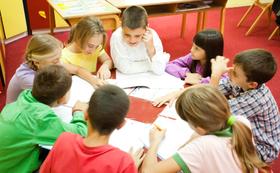Serving 375 students in grades 7-12, Casey-westfield Jr/sr High School ranks in the top 50% of all schools in Illinois for overall test scores (math proficiency is top 50%, and reading proficiency is top 50%).
The percentage of students achieving proficiency in math is 20-24% (which is lower than the Illinois state average of 27%). The percentage of students achieving proficiency in reading/language arts is 30-34% (which is approximately equal to the Illinois state average of 30%).
The student-teacher ratio of 15:1 is higher than the Illinois state level of 13:1.
Minority enrollment is 5% of the student body (majority Black and Hispanic), which is lower than the Illinois state average of 55% (majority Hispanic).
Quick Facts (2025-26)
- Grades: 7-12
- Enrollment: 375 students
- Student-Teacher Ratio: 15:1
- Minority Enrollment: 5%
- Graduation Rate: 85-89% (Top 50% in IL)
- Overall Testing Rank: Top 50%
- Math Proficiency: 20-24% (Top 50%)
- Reading Proficiency: 30-34% (Top 50%)
- Science Proficiency: 60-64% (Top 30%)
- Source: National Center for Education Statistics (NCES), IL Dept. of Education
Top Rankings
Casey-westfield Jr/sr High School ranks among the top 20% of public schools in Illinois for:
Category
Attribute
Most improved public schools
School Overview
Casey-westfield Jr/sr High School's student population of 375 students has stayed relatively flat over five school years.
The teacher population of 25 teachers has declined by 10% over five school years.
Grades Offered
Grades 7-12
Total Students
375 students
Gender %
Total Classroom Teachers
25 teachers
School Calendar
School Motto
Never Stop Learning
School Rankings
Casey-westfield Jr/sr High School ranks within the top 50% of all 3,542 schools in Illinois (based off of combined math and reading proficiency testing data).
The diversity score of Casey-westfield Jr/sr High School is 0.10, which is less than the diversity score at state average of 0.69. The school's diversity has stayed relatively flat over five school years.
Overall Testing Rank
#1462 out of 3542 schools
(Top 50%)
(Top 50%)
Math Test Scores (% Proficient)
20-24%
27%
Reading/Language Arts Test Scores (% Proficient)
30-34%
30%
Science Test Scores (% Proficient)
60-64%
50%
Student-Teacher Ratio
15:1
13:1
American Indian
n/a
n/a
Asian
1%
6%
Hispanic
2%
28%
Black
2%
17%
White
95%
45%
Hawaiian
n/a
n/a
Two or more races
n/a
4%
All Ethnic Groups
Graduation Rate
85-89%
87%
Eligible for Free Lunch
45%
43%
Eligible for Reduced Lunch
5%
4%
School Statewide Testing
School District Name
Source: National Center for Education Statistics (NCES), IL Dept. of Education
Profile last updated: 02/09/2025
Frequently Asked Questions
What is Casey-westfield Jr/sr High School's ranking?
Casey-westfield Jr/sr High School is ranked #1462 out of 3,542 schools, which ranks it among the top 50% of public schools in Illinois.
What schools are Casey-westfield Jr/sr High School often compared to?
Casey-westfield Jr/sr High Schoolis often viewed alongside schools like Marshall High School, Martinsville Jr- Sr High School, Effingham High School by visitors of our site.
What percent of students have achieved state testing proficiency in math and reading?
20-24% of students have achieved math proficiency (compared to the 27% IL state average), while 30-34% of students have achieved reading proficiency (compared to the 30% IL state average).
What is the graduation rate of Casey-westfield Jr/sr High School?
The graduation rate of Casey-westfield Jr/sr High School is 85-89%, which is lower than the Illinois state average of 87%.
How many students attend Casey-westfield Jr/sr High School?
375 students attend Casey-westfield Jr/sr High School.
What is the racial composition of the student body?
95% of Casey-westfield Jr/sr High School students are White, 2% of students are Black, 2% of students are Hispanic, and 1% of students are Asian.
What is the student-teacher ratio of Casey-westfield Jr/sr High School?
Casey-westfield Jr/sr High School has a student ration of 15:1, which is higher than the Illinois state average of 13:1.
What grades does Casey-westfield Jr/sr High School offer ?
Casey-westfield Jr/sr High School offers enrollment in grades 7-12
What school district is Casey-westfield Jr/sr High School part of?
Casey-westfield Jr/sr High School is part of Casey-Westfield Community Unit School District 4c.
School Reviews
2 10/10/2025
The majority of the academic programs are up to par with preparation for college. However, the Physical Science department is somewhat lacking, as is the Math for the preparation for college. The availability of extracurricular activities is vast, with a lot of emphasis on sports. Scholastic and art is not very present though. Academic and athletic awards are present. The facilities, are, unfortunately, not good at all. An entire section of the building has been condemned, what was once known as the library and study area. This has disabled a good part of the center of the school. Parental involvement is normally limited to sports.
Review Casey-westfield Jr/sr High School. Reviews should be a few sentences in length. Please include any comments on:
- Quality of academic programs, teachers, and facilities
- Availability of music, art, sports and other extracurricular activities
Recent Articles

Public School Open House & Enrollment Season Guide
A parent-focused guide to the public school open house and enrollment season, with expert questions, timelines, and decision tips.

School Supply Budget 2026: Fees, Books, Tech Costs
School Supply Budget 2026 guide for parents, covering fees, textbooks, technology, and hidden extras to plan ahead.

Education Funding in America (2025 Update)
Comprehensive 2025 update on public school funding in America, new federal and state policies, per-pupil spending, and equity challenges.





